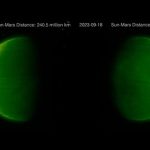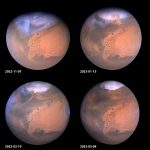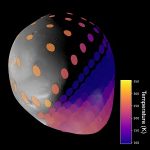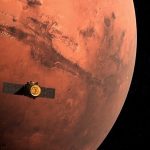The probe's digital camera captured three 'blue, green and red' visible spectra, which represented a precise and detailed picture of the red planet's atmosphere.
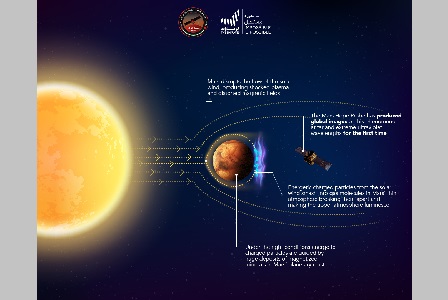 The Emirates Mars Mission, the first interplanetary exploration undertaken by an Arab nation, has released the first global images of Mars in the far-ultraviolet, providing new insights into the discrete aurora phenomenon in the nightside atmosphere.
The Emirates Mars Mission, the first interplanetary exploration undertaken by an Arab nation, has released the first global images of Mars in the far-ultraviolet, providing new insights into the discrete aurora phenomenon in the nightside atmosphere.
The UAE Hope Probe was able to take three pictures of the atmosphere of Mars, in its first working mission after the successful entry into the orbit of the red planet in February.
Speaking about the new development, Emirates Mars Mission Science Lead, Hessa Al Matroushi, said: “These unique global snapshots of the discrete aurora of Mars are the first time such detailed and clear observations have been made globally, as well as across previously unobservable wavelengths. The implications for our understanding of Mars’ atmospheric and magnetospheric science are tremendous and provide new support to the theory that solar storms are not necessary to drive Mars’ aurora. Mars’ aurorae are an area of intense interest to the global scientific community and their study has tremendous potential to challenge, expand and deepen our understanding of Mars’ atmosphere and its interaction with the planet and with solar energies. We were hopeful that EMUS could make a contribution in this area but we now know with absolute certainty that contribution is going to be ground breaking.”
The images, taken by the Hope Probe’s EMUS (Emirates Mars Ultraviolet Spectrometer) instrument, show a ghostly glow known as the discrete aurora. Its intricate patterns trace out the regions where Mars’ enigmatic crustal magnetic fields act like a funnel to guide fast electrons from space down into the atmosphere, causing it to shimmer in a manner similar to Earth’s aurora. This influence of localised magnetic fields is a unique feature of the Red Planet as Mars, unlike Earth, does not have a global magnetic field generated by the planet’s core. The most sensitive ultraviolet instrument yet to orbit Mars, EMUS is able to image these dynamic auroral events globally at high resolution and across a wide range of wavelengths, providing an unprecedented window upon the interaction of the atmosphere with solar particles.
While previous studies had theorised the discrete aurora is tied to Mars’ magnetic fields and existing observations had been consistent with that theory, prior images of this phenomenon at this quality had only been available as artist’s impressions.
EMM Deputy Science Lead Justin Deighan, added: “We have totally blown out ten years of study of Mars’ auroras with ten minutes of observations. The data we are capturing confirms the tremendous potential we now have of exploring Mars’ aurora and the interactions between Mars’ magnetic fields, atmosphere and solar particles with a coverage and sensitivity we could only previously dream of. These exciting observations go above and beyond the original science goals of the Emirates Mars Mission.”
One of three instruments onboard the Mars Hope Probe, EMUS’ principal science goal is the measurement of oxygen and carbon monoxide in Mars’ thermosphere and the variability of hydrogen and oxygen in the exosphere. Members of the science team who had previously worked on the MAVEN Mission had recognised the potential for the more sensitive EMUS instrument to capture new aspects of Mars’ auroral phenomena, but the results of early observations have exceeded their wildest expectations.
Three types of aurora have been observed around Mars to date: the diffuse aurora are observed only during intense solar storms, when interactions with the highest energy particles cause the atmosphere around the entire planet to light up. In contrast, the discrete aurora is highly localised and observations made to date have appeared to bear out the theory that it is directly linked to the patchy magnetic fields produced by magnetized minerals embedded in Mars’ surface. Both of these aurorae are observed on Mars’ nightside, while a third class, the proton aurora, has been measured on Mars’ dayside and is driven by interactions between the solar wind and Hydrogen in Mars’ exosphere. These three types of aurora had previously been identified by ultraviolet instruments aboard the Mars Express and MAVEN missions orbiting Mars, but clear global images of the discrete aurora were elusive until the new observations by EMM.
Hope is following its planned 20,000 – 43,000 km elliptical science orbit, with an inclination to Mars of 25 degrees. The probe will complete one orbit of the planet every 55 hours and will capture a full planetary data sample every nine days in a two-year mission to map Mar’s atmospheric dynamics.










































































